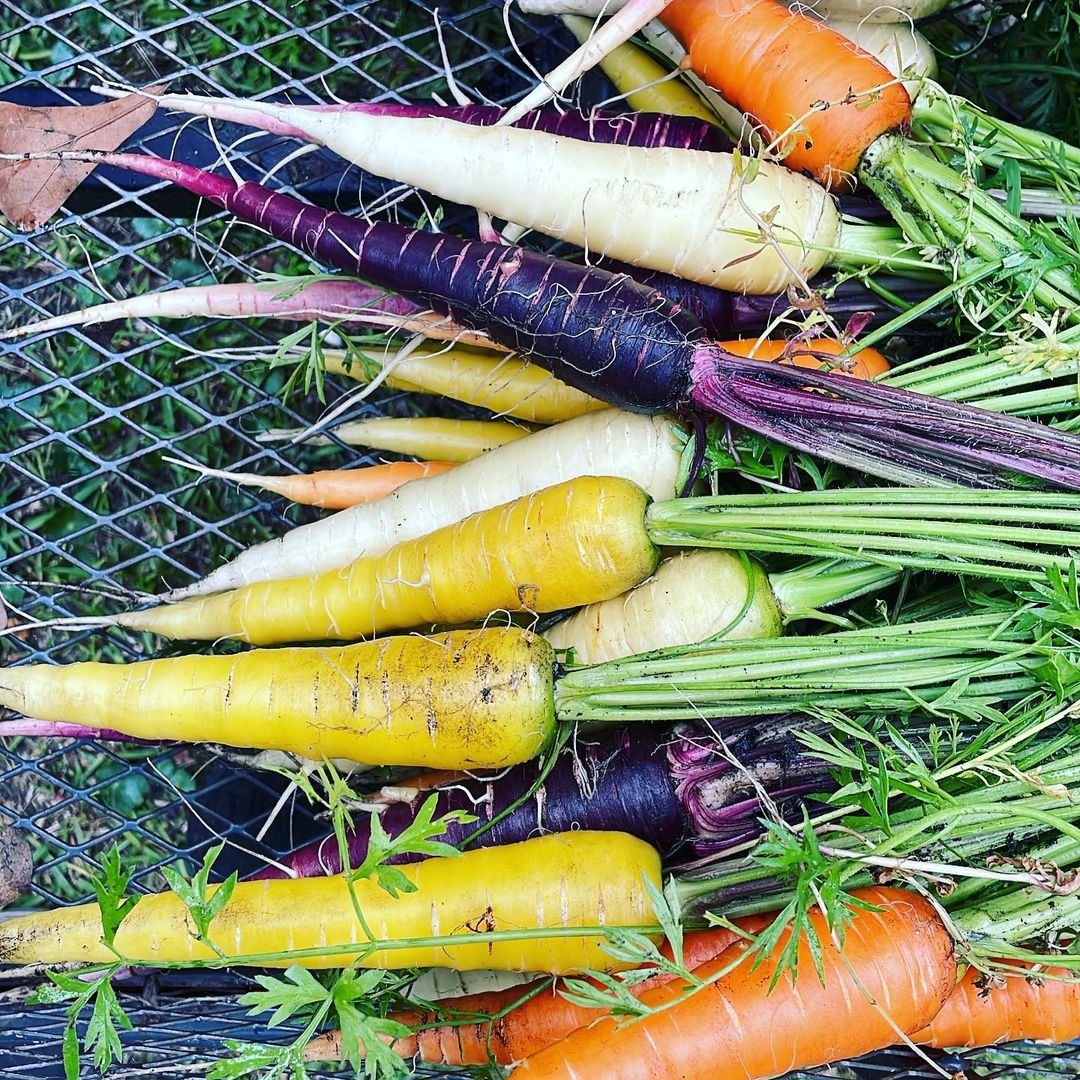Discover the joy of cultivating your own fresh, crisp carrots right in your backyard! This comprehensive guide covers everything from choosing the perfect variety to preparing the soil, sowing seeds, identifying carrot sprouts and seedlings, caring for your crop and harvesting a bountiful yield of delicious homegrown carrots.
There’s nothing quite like the sweet, earthy flavor of a freshly pulled carrot straight from your garden. Homegrown carrots are not only a delightful addition to your meals but also a rewarding and surprisingly easy crop to cultivate. Whether you’re a seasoned gardener or a beginner.
How to grow carrots

Here’s a concise information chart about carrots:
| Attribute | Description |
|---|---|
| Scientific Name | Daucus carota |
| Family | Apiaceae |
| Origin | Likely from Persia (modern-day Iran and Afghanistan) |
| Type | Root vegetable |
| Color Varieties | Orange, purple, black, red, white, yellow |
| Nutritional Value | High in beta-carotene (precursor to vitamin A), fiber, vitamin K1, potassium, antioxidants |
| Calories | Approximately 41 calories per 100 grams |
| Health Benefits | Improves vision, boosts immunity, promotes skin health, reduces cancer risk, aids digestion |
| Common Uses | Raw in salads, cooked in soups and stews, juiced, in desserts (carrot cake) |
| Growing Conditions | Cool-season crop, well-drained soil, full sun exposure |
| Harvest Time | Generally 70-80 days after planting |
| Storage | Best stored in cool, moist conditions (refrigerator) |
| Interesting Fact | The modern orange carrot was developed in the Netherlands in the 17th century to honor the House of Orange. |
this step-by-step guide will provide you with all the knowledge and tips you need to grow a bountiful harvest of crisp, flavorful carrots right in your backyard.
Step 1: Choosing the Right Carrot Variety
The first step in your carrot-growing journey is selecting the perfect variety for your garden. Here are some popular options to consider:
Nantes

Here’s a short information chart for Nantes Carrots:
| Attribute | Information |
|---|---|
| Botanical Name | Daucus carota subsp. sativus |
| Plant Type | Biennial (grown as an annual) |
| Soil Type | Loose, well-drained, sandy or loamy soil |
| Color Varieties | Bright orange |
| Zones | 3-10 (USDA Hardiness Zones) |
| Exposure | Full sun to partial shade |
| Days to Maturity | 65-70 days |
| Height/Spread | 8-12 inches tall / 2-3 inches wide (root length 6-7 inches) |
A classic choice, Nantes carrots are cylindrical, smooth and sweet, making them perfect for fresh eating or cooking.
Chantenay

Here’s a short information chart for Chantenay Carrots:
| Attribute | Information |
|---|---|
| Botanical Name | Daucus carota subsp. sativus |
| Plant Type | Biennial (grown as an annual) |
| Soil Type | Loose, well-drained, sandy or loamy soil |
| Color Varieties | Bright orange |
| Zones | 3-10 (USDA Hardiness Zones) |
| Exposure | Full sun to partial shade |
| Days to Maturity | 65-75 days |
| Height/Spread | 8-12 inches tall / 2-3 inches wide (root length 5-6 inches) |
Known for their broad shoulders and tapered shape, Chantenay carrots are ideal for growing in heavy or rocky soils.
Imperator

Here’s a short information chart for Imperator Carrots:
| Attribute | Information |
|---|---|
| Botanical Name | Daucus carota subsp. sativus |
| Plant Type | Biennial (grown as an annual) |
| Soil Type | Deep, loose, well-drained, sandy or loamy soil |
| Color Varieties | Bright orange |
| Zones | 3-10 (USDA Hardiness Zones) |
| Exposure | Full sun to partial shade |
| Days to Maturity | 65-75 days |
| Height/Spread | 12-18 inches tall / 2-3 inches wide (root length 7-10 inches) |
These long, slender carrots are perfect for juicing or grating and they store well for extended periods.
Rainbow Blend

Here’s a short information chart for Rainbow Blend Carrots:
| Attribute | Information |
|---|---|
| Botanical Name | Daucus carota subsp. sativus |
| Plant Type | Biennial (grown as an annual) |
| Soil Type | Loose, well-drained, sandy or loamy soil |
| Color Varieties | Orange, yellow, red, purple, white |
| Zones | 3-10 (USDA Hardiness Zones) |
| Exposure | Full sun to partial shade |
| Days to Maturity | 60-75 days |
| Height/Spread | 8-12 inches tall / 2-3 inches wide (root length varies by variety, typically 6-8 inches) |
For a vibrant and visually appealing crop, try a rainbow blend that includes a mix of purple, yellow, white and orange carrots.
Step 2: Preparing the Soil

Carrots thrive in loose, well-draining soil that is free from rocks and debris. To prepare the perfect carrot bed, follow these steps:
- Choose a sunny location: Carrots prefer full sun exposure, with at least 6-8 hours of direct sunlight daily.
- Loosen the soil: Use a garden fork or tiller to loosen the soil to a depth of at least 12 inches. This allows the carrot roots to grow long and straight.
- Remove debris: Carefully remove any rocks, sticks or other debris from the soil as these can cause the carrots to become misshapen or forked.
- Add compost or aged manure: Incorporate a generous amount of nutrient-rich compost or well-rotted manure into the soil to improve drainage and fertility.
Step 3: Sowing the Seeds and Identifying Carrot Sprouts

Once your soil is prepared, it’s time to sow the carrot seeds:
- Sowing depth: Sow the seeds approximately 1/4 inch deep and 1 inch apart in rows spaced 12-18 inches apart.
- Thin seedlings: After germination, thin the seedlings to 2-3 inches apart to allow proper root development and prevent overcrowding.
- Succession planting: For a continuous harvest, consider sowing new seeds every 2-3 weeks during the growing season.
What do carrot sprouts look like when they first emerge?
Carrot sprouts are delicate and thread-like, with a single thin stem and a pair of narrow, elongated seed leaves called cotyledons. As they grow the true carrot leaves will unfurl, appearing fern-like and feathery.
Step 4: Caring for Your Carrot Crop

Proper care is essential for ensuring a healthy and bountiful carrot harvest. Follow these tips:
- Watering: Carrots require consistent moisture especially during the early growth stages. Water deeply, aiming for about 1 inch of water per week.
- Weed control: Keep the carrot bed free from weeds, as they can compete for nutrients and water. Mulching can help suppress weed growth.
- Thinning: As the carrots grow, continue thinning them to a final spacing of 3-4 inches apart to prevent overcrowding and allow for proper root development.
- Fertilizing: Carrots benefit from a balanced fertilizer applied at the time of planting and again when the roots begin to swell.
Why are my carrots so small? There are a few potential reasons for stunted carrot growth:
- Overcrowding: Carrots that are not thinned properly will compete for resources, resulting in smaller roots.
- Lack of nutrients: Insufficient fertilizer or poor soil quality can stunt carrot growth.
- Hot weather: Carrots prefer cooler temperatures and may become stunted in extreme heat.
- Soil compaction: Compacted soil can restrict root growth, leading to smaller, misshapen carrots.
Step 5: Harvesting Your Homegrown Carrots

When it comes to harvesting, timing is key. Here’s how to know when your carrots are ready to be picked:
- Check the top: The shoulders of the carrot should be visible above the soil surface, indicating they’ve reached maturity.
- Look for size: Most carrot varieties are ready to harvest when they reach approximately 1/2 inch in diameter at the top.
- Harvest method: Carefully loosen the soil around the carrot with a garden fork or your hands, and gently pull the carrot from the ground, being careful not to break the taproot.
- Storage: Fresh carrots can be stored in the refrigerator for up to 2 weeks. For longer-term storage, place them in a cool, humid location like a root cellar or bury them in damp sand or sawdust.
Growing your own carrots is a rewarding experience that not only provides you with fresh, nutrient-rich produce but also offers a sense of accomplishment and connection to nature. By following this step-by-step guide, you’ll be well-equipped to choose the perfect carrot variety, prepare the ideal growing environment, identify carrot sprouts and seedlings, and nurture your crop from seed to harvest. Embrace the joys of homegrown carrot goodness and enjoy the sweet, crisp flavors of your own backyard bounty.
Pingback: 16 Types of Yellow Mushrooms (with Pictures)
Pingback: Which Hostas Can Grow in the Sun? Gardeners Schools
Pingback: How to Grow Vegetables Indoors : A Complete Guide